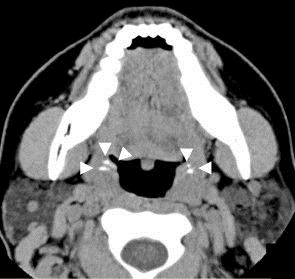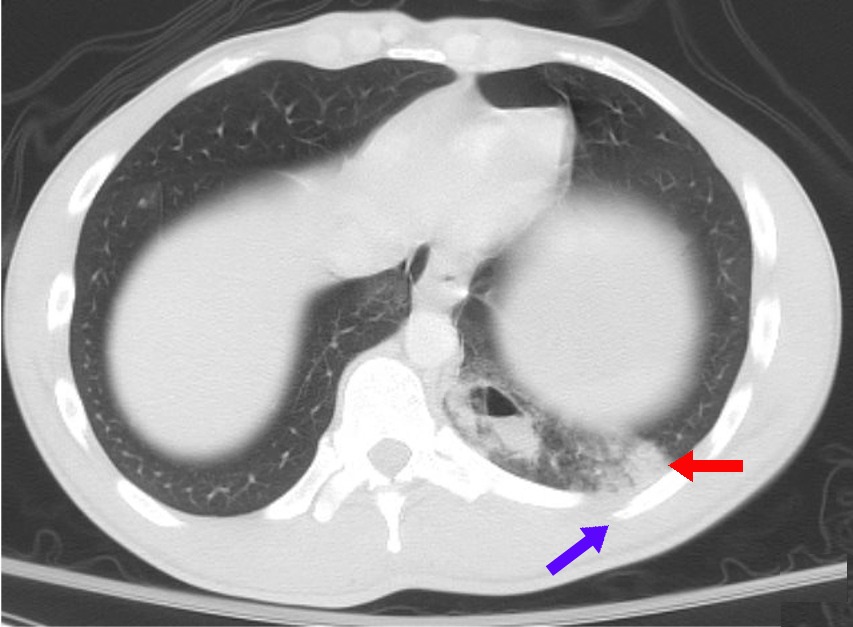|
Tonsillolith
Tonsil stones, also known as tonsilloliths, are mineralizations of debris within the crevices of the tonsils. When not mineralized, the presence of debris is known as chronic caseous tonsillitis (CCT). Symptoms may include bad breath, foreign body sensation, sore throat, pain or discomfort with swallowing, and cough. Generally there is no pain, though there may be the feeling of something present. The presence of tonsil stones may be otherwise undetectable; however, some people have reported seeing white material in the rear of their throat. Risk factors may include recurrent throat infections. Tonsil stones contain a biofilm composed of a number of different bacteria, and calcium salts, either alone or in combination with other mineral salts. While they most commonly occur in the palatine tonsils, they may also occur in the adenoids, lingual tonsils and tubal tonsil. Tonsil stones have been recorded weighing from 0.3g to 42g, and they are typically small in size. However, ... [...More Info...] [...Related Items...] OR: [Wikipedia] [Google] [Baidu] |
Asymptomatic Condition
Asymptomatic (or clinically silent) is an adjective categorising the medical conditions (i.e., injuries or diseases) that patients carry but without experiencing their symptoms, despite an explicit diagnosis (e.g., a positive medical test). Pre-symptomatic is the adjective categorising the time periods during which the medical conditions are asymptomatic. Subclinical and paucisymptomatic are other adjectives categorising either the asymptomatic infections (i.e., subclinical infections), or the psychosomatic illnesses and mental disorders expressing a subset of symptoms but not the entire set an explicit medical diagnosis requires. Examples An example of an asymptomatic disease is cytomegalovirus (CMV) which is a member of the herpes virus family. "It is estimated that 1% of all newborns are infected with CMV, but the majority of infections are asymptomatic." (Knox, 1983; Kumar et al. 1984) In some diseases, the proportion of asymptomatic cases can be important. For example ... [...More Info...] [...Related Items...] OR: [Wikipedia] [Google] [Baidu] |
Tonsillitis
Tonsillitis is inflammation of the tonsils in the upper part of the throat. It can be acute or chronic. Acute tonsillitis typically has a rapid onset. Symptoms may include sore throat, fever, enlargement of the tonsils, trouble swallowing, and enlarged lymph nodes around the neck. Complications include peritonsillar abscess, peritonsillar abscess (quinsy). Tonsillitis is most commonly caused by a viral infection and about 5% to 40% of cases are caused by a bacterial infection.Lang 2009p. 2083./ref> When caused by the bacterium group A streptococcus, it is classed as streptococcal tonsillitis also referred to as ''strep throat''. Rarely bacteria such as ''Neisseria gonorrhoeae'', ''Corynebacterium diphtheriae'', or ''Haemophilus influenzae'' may be the cause. Typically the infection is spread between people through the air. A scoring system, such as the Centor score, may help separate possible causes. Confirmation may be by a throat swab or rapid strep test. Treatment efforts in ... [...More Info...] [...Related Items...] OR: [Wikipedia] [Google] [Baidu] |
Otorhinolaryngology
Otorhinolaryngology ( , abbreviated ORL and also known as otolaryngology, otolaryngology–head and neck surgery (ORL–H&N or OHNS), or ear, nose, and throat (ENT)) is a surgical subspecialty within medicine that deals with the surgical and medical management of conditions of the head and neck. Doctors who specialize in this area are called otorhinolaryngologists, otolaryngologists, head and neck surgeons, or ENT surgeons or physicians. Patients seek treatment from an otorhinolaryngologist for diseases of the ear, Human nose, nose, throat, base of skull, base of the skull, head, and neck. These commonly include functional diseases that affect the senses and activities of eating, drinking, speaking, breathing, swallowing, and hearing. In addition, ENT surgery encompasses the surgical management of cancers and benign tumors and reconstruction of the head and neck as well as plastic surgery of the face, scalp, and neck. Etymology The term is a combination of Neo-Latin classic ... [...More Info...] [...Related Items...] OR: [Wikipedia] [Google] [Baidu] |
Medical Imaging
Medical imaging is the technique and process of imaging the interior of a body for clinical analysis and medical intervention, as well as visual representation of the function of some organs or tissues (physiology). Medical imaging seeks to reveal internal structures hidden by the skin and bones, as well as to diagnose and treat disease. Medical imaging also establishes a database of normal anatomy and physiology to make it possible to identify abnormalities. Although imaging of removed organ (anatomy), organs and Tissue (biology), tissues can be performed for medical reasons, such procedures are usually considered part of pathology instead of medical imaging. Measurement and recording techniques that are not primarily designed to produce images, such as electroencephalography (EEG), magnetoencephalography (MEG), electrocardiography (ECG), and others, represent other technologies that produce data susceptible to representation as a parameter graph versus time or maps that contain ... [...More Info...] [...Related Items...] OR: [Wikipedia] [Google] [Baidu] |
Biofilms
A biofilm is a syntrophic community of microorganisms in which cells stick to each other and often also to a surface. These adherent cells become embedded within a slimy extracellular matrix that is composed of extracellular polymeric substances (EPSs). The cells within the biofilm produce the EPS components, which are typically a polymeric combination of extracellular polysaccharides, proteins, lipids and DNA. Because they have a three-dimensional structure and represent a community lifestyle for microorganisms, they have been metaphorically described as "cities for microbes". Biofilms may form on living (biotic) or non-living (abiotic) surfaces and can be common in natural, industrial, and hospital settings. They may constitute a microbiome or be a portion of it. The microbial cells growing in a biofilm are physiologically distinct from planktonic cells of the same organism, which, by contrast, are single cells that may float or swim in a liquid medium. Biofilms c ... [...More Info...] [...Related Items...] OR: [Wikipedia] [Google] [Baidu] |
Submucosa
The submucosa (or tela submucosa) is a thin layer of tissue in various organs of the gastrointestinal, respiratory, and genitourinary tracts. It is the layer of dense irregular connective tissue that supports the mucosa (mucous membrane) and joins it to the muscular layer, the bulk of overlying smooth muscle (fibers running circularly within layer of longitudinal muscle). The submucosa ('' sub-'' + ''mucosa'') is to a mucous membrane what the subserosa ('' sub-'' + ''serosa'') is to a serous membrane. Structure Blood vessels, lymphatic vessels, and nerves (all supplying the mucosa) will run through here. In the intestinal wall, tiny parasympathetic ganglia are scattered around forming the submucous plexus (or "Meissner's plexus") where preganglionic parasympathetic neurons synapse with postganglionic nerve fibers that supply the muscularis mucosae. Histologically, the wall of the alimentary canal shows four distinct layers (from the lumen moving out): mucosa, submuc ... [...More Info...] [...Related Items...] OR: [Wikipedia] [Google] [Baidu] |
Otalgia
Ear pain, also known as earache or otalgia, is pain in the ear. Primary ear pain is pain that originates from the ear. Secondary ear pain is a type of referred pain, meaning that the source of the pain differs from the location where the pain is felt. Most causes of ear pain are non-life-threatening. Primary ear pain is more common than secondary ear pain, and it is often due to infection or injury. The conditions that cause secondary (referred) ear pain are broad and range from temporomandibular joint syndrome to inflammation of the throat. In general, the reason for ear pain can be discovered by taking a thorough history of all symptoms and performing a physical examination, without need for imaging tools like a CT scan. However, further testing may be needed if red flags are present like hearing loss, dizziness, ringing in the ear or unexpected weight loss. Management of ear pain depends on the cause. If there is a bacterial infection, antibiotics are sometimes recommended an ... [...More Info...] [...Related Items...] OR: [Wikipedia] [Google] [Baidu] |
Sore Throat
Sore throat, also known as throat pain, is pain or irritation of the throat. The majority of sore throats are caused by a virus, for which antibiotics are not helpful. For sore throat caused by bacteria (GAS), treatment with antibiotics may help the person get better faster, reduce the risk that the bacterial infection spreads, prevent retropharyngeal abscesses and quinsy, and reduce the risk of other complications such as rheumatic fever and rheumatic heart disease. In most developed countries, post-streptococcal diseases have become far less common. For this reason, awareness and public health initiatives to promote minimizing the use of antibiotics for viral infections have become the focus. Approximately 35% of childhood sore throats and 5–25% of cases in adults are caused by a bacterial infection from group A streptococcus. Sore throats that are "non-group A streptococcus" are assumed to be caused by a viral infection. Sore throat is a common reason for people to vi ... [...More Info...] [...Related Items...] OR: [Wikipedia] [Google] [Baidu] |
X-ray Computed Tomography
An X-ray (also known in many languages as Röntgen radiation) is a form of high-energy electromagnetic radiation with a wavelength shorter than those of ultraviolet rays and longer than those of gamma rays. Roughly, X-rays have a wavelength ranging from 10 nanometers to 10 picometers, corresponding to frequencies in the range of 30 petahertz to 30 exahertz ( to ) and photon energies in the range of 100 eV to 100 keV, respectively. X-rays were discovered in 1895 by the German scientist Wilhelm Conrad Röntgen, who named it ''X-radiation'' to signify an unknown type of radiation.Novelline, Robert (1997). ''Squire's Fundamentals of Radiology''. Harvard University Press. 5th edition. . X-rays can penetrate many solid substances such as construction materials and living tissue, so X-ray radiography is widely used in medical diagnostics (e.g., checking for broken bones) and materials science (e.g., identification of some chemical elements and ... [...More Info...] [...Related Items...] OR: [Wikipedia] [Google] [Baidu] |
Voiceless Velar Fricative
The voiceless velar fricative is a type of consonantal sound used in some spoken languages. It was part of the consonant inventory of Old English and can still be found in some dialects of English, most notably in Scottish English, e.g. in ''loch'', ''broch'' or ''saugh'' (willow). The symbol in the International Phonetic Alphabet that represents this sound is , the Latin letter x. It is also used in broad transcription instead of the symbol , the Greek chi, for the voiceless uvular fricative. There is also a voiceless post-velar fricative (also called pre-uvular) in some languages, which can be transcribed as or . For voiceless pre-velar fricative (also called post-palatal), see voiceless palatal fricative. Some scholars also posit the voiceless velar approximant distinct from the fricative, used in some spoken languages. The symbol in the International Phonetic Alphabet that represents this sound is , but this symbol is not suitable in case of the voiceless velar appr ... [...More Info...] [...Related Items...] OR: [Wikipedia] [Google] [Baidu] |







